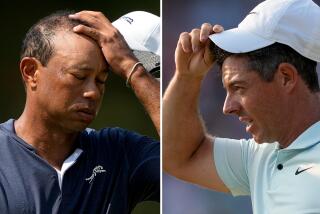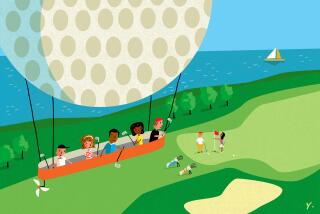First Day Is Often for Outsiders
ROCHESTER, N.Y. — Welcome to Wuthering Heights West.
How do you par a swamp? What club do you use for ooze?
If you’re ever in Rochester, bring a raft. It’s hard to tell where the Genesee River leaves off and the town begins. It’d be a nice town, but it leaks. Two more days of this and the Open may find itself on Mt. Ararat.
You would think a golf course like this would be harder to play in the rain than a tuba. Not so. It plays longer. You don’t get any roll. But it plays softer. You don’t want any roll on a green.
The leader board looks as if it’s bleeding to death. Red numbers, signifying under-par scores, make it look like an explosion in a ketchup factory. You can play target golf when the greens are as soft as a bowl of Cream of Wheat. The ball sticks like a dart where you hit it.
Ordinarily, you can’t fly a ball at the flagstick in a U.S. Open. The greens are harder than a landlord’s heart. The fairways move a ball faster than an ocelot. You defend yourself against a U.S. Open course, usually.
When it’s wet, you fly at its throat.
The old-timers in this 89th U.S. Open field can’t believe their good luck. They try not to lick their chops as they look out there and see a bog instead of a dance floor.
You look at the leader board and it looks like the Supreme Court. Not precisely the nine old men but certainly the three wise men and company. There’s Jack W. Nicklaus. And Raymond Floyd. There’s Tom Kite. You keep looking around for Gene Littler.
These guys know what to do with an Open course that’s lying on its side with an arrow in it. They’re like Dempsey with his man on the ropes and cut.
See Jack Nicklaus as he comes in with a 67.
“Any time you have rain, it modifies the peril of an Open course,” Nicklaus concedes. “The golf course gets easier, even if it gets longer. The fire of a U.S. Open golf course is the fastness of its greens and fairways. Rain dampens this fire.”
A U.S. Open is supposed to belong to the guys who have been here before. It is like a college reunion. It’s supposed to belong to the legends.
The lords of the game fly in on their own jets or the Concorde from Europe. They have people who meet them with limos, they stay in private homes, have breakfast in bed and dinner in sumptuous private dining rooms.
They usually make the history books, but they don’t always make the first-day headlines.
Sometimes you have to remember that a young Ben Hogan once teed it up in one of these things with the dew cutters’ patrol, mail-order slacks on his skinny butt, fingers trembling slightly as he wrapped them around the club, maybe a ball with a little cut in it and clubs with electrician’s tape on the handles.
The lowest scores for single rounds are not always shot by name pros. The golf world was shocked in 1950 when someone named Lee Mackey Jr. stepped up with the dawn patrol and shot an opening 64, the lowest score ever posted to that time in a U.S. Open.
The glass slipper didn’t fit. Lee Mackey Jr. shot an 81 the next day and wound up making $100 for the week and drifting out of the public eye except as a trivia question.
But it took 16 years for another player to match that score. A club pro out of Texas, Rives McBee, shot his 64 in the second round. But when he surrounded that with rounds of 78-76-74, he managed to take only $1,700 back to Midland.
There are 156 players in this Open field. There are only about 50 who realistically can win. Still, there are a lot of guys who come here with dreams of glory dancing in their heads but not much money in their lockers. No one sends a jet--or even a limo or taxi--for them. No one knows their names. They put up at a motel that has a telephone, king-sized bed, telephone and shower over the tub. They probably eat in the room.
The world expects them to be gone by Friday night, when the field is scissored to accommodate the real high-rollers and send the ribbon clerks on their way back to the mini-tour or a job cleaning clubs in Ottumwa.
No one gets in this thing on a pass or a note from home. You shoot your way into an Open. The aristocracy make it on past performance--they won this event in the past 10 years or a Masters or British Open in the past five. Or, they’ve won a million or so dollars on the tour in the past year and a half.
Emlyn Aubrey is none of the above. He got in this thing basically because he won--a little traveling music, professor--the Philippines Open!
That was a tournament Seve Ballesteros and Jack Nicklaus never did have to tee it up in, but Aubrey tried three times to get his tour card on this continent. When he couldn’t, he had to round up three sponsors from his hometown of Reading, Pa., and see if they would bankroll him on the Asian tour.
Not too many guys would take their clubs to Kuala Lumpur and courses where they had to chase the monkeys--and the cobras--off so they could tee it up. But Aubrey didn’t have much choice.
There was more than $36 million to be played for on the American tour last year, but the Asian tour held out considerably less. About $35 1/2 million less.
Still, it’s like cleaning elephants. You have to do it if you want to stay in show business. So, Aubrey took the act to the jungles.
ABC didn’t have any cameras there. In the Philippines Open, he didn’t have to hold off Greg Norman or Fuzzy Zoeller. In fact, he had to make up seven shots in the final round against a Swedish golfer, who obligingly shot a final- round 77. Sweden, of course, does not have a winter tour.
Arnold Palmer has his own jet, but the players on the Asian tour travel in converted World War II cargo planes. The one Aubrey found himself in, flying from Pakistan to Calcutta, had the requisite number of engines and wheels. The only trouble was the fuselage. It had this little 6-inch hole in the floor. He could see the ground real clear.
Now, if you know anything about flying, you know that, at altitude, a hole in an airplane tends to get bigger and a condition known as explosive decompression takes place, which can suck you and whoever’s near you right out of the plane and into the Indian Ocean.
Fortunately, Aubrey’s plane never got much higher off the ground than the hedges. He got safely to Calcutta--if that’s a place any golfer would really want to be--but after that experience, a 15-foot, two-break putt would be a box of chocolates.
Winning the Philippines Open didn’t put Aubrey in the U.S. Open, although it did the British. Here, he had to undergo sectional qualifying at the site of the Kemper Open. Winning at Manila merely excused him from the first qualifying, or local, stage.
He shot a 69 Thursday and briefly led the U.S. Open, since his was the third group to tee off. Leading the Open when you have a 7:27 tee-off time is no great trick and some of the registered giants of the game had already gone by him by the time the sun set on Oak Hill.
Winning the U.S. Open and the Philippines Open in the same year is not exactly the Grand Slam. But Aubrey’s the only one who’s still alive in that difficult double. Look at it this way: Did Hogan ever do it?
More to Read
Go beyond the scoreboard
Get the latest on L.A.'s teams in the daily Sports Report newsletter.
You may occasionally receive promotional content from the Los Angeles Times.










